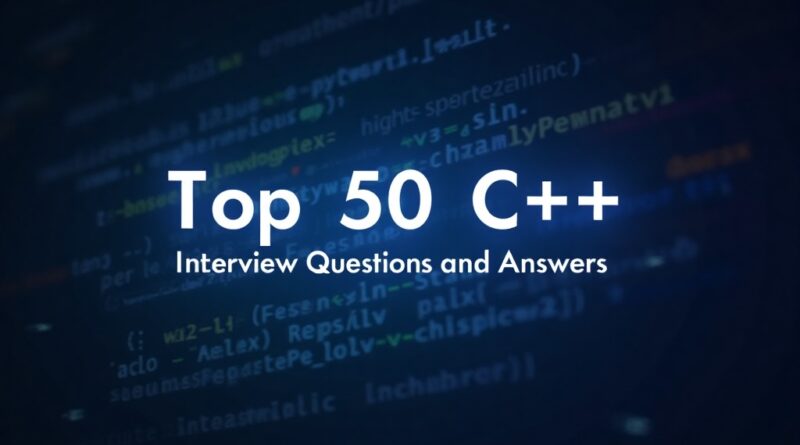50 Most Important C++ Interview Questions and Answers
Table of Contents
Toggle50 Most Important C++ Interview Questions and Answers for Job Interviews
Introduction
C++ remains one of the most powerful programming languages widely used in software development, game development, system programming, and more. Its blend of low-level control and object-oriented features makes it a favorite among employers. To help you ace your C++ interview, here are 50 carefully curated questions with in-depth answers and examples that cover everything from basic concepts to advanced features.
1. What is C++?
Answer:
C++ is a high-level programming language developed by Bjarne Stroustrup as an extension of the C language. It supports multiple programming paradigms, including procedural, object-oriented, and generic programming. C++ is widely used because of its efficiency and control over system resources.
Example:
#include <iostream>
int main() {
std::cout << "Hello, C++!" << std::endl;
return 0;
}
This simple program prints “Hello, C++!” to the console using the standard output stream.
2. What are the key features of C++?
Answer:
-
Object-Oriented Programming (OOP): Supports encapsulation, inheritance, polymorphism, and abstraction.
-
Function and Operator Overloading: Allows functions and operators to be defined multiple times with different parameters.
-
Templates: Enable generic programming allowing functions and classes to operate with any data type.
-
Exception Handling: Provides a robust mechanism to handle runtime errors using
try,catch, andthrow. -
Standard Template Library (STL): A rich library offering data structures like vectors, lists, maps, and algorithms for efficient programming.
3. What is a class and an object?
Answer:
A class is a blueprint that defines properties (data members) and behaviors (member functions) of objects. An object is an instance of a class, representing a specific entity with its own set of data.
Example:
class Car {
public:
std::string brand;
void honk() {
std::cout << "Beep Beep!" << std::endl;
}
};Car myCar;
myCar.brand = “Tesla”;
myCar.honk();
}
Here, Car is a class with a brand attribute and a honk behavior. myCar is an object of the class.
4. What is encapsulation?
Answer:
Encapsulation means bundling data and methods that operate on the data within one unit (class) and restricting direct access to some of the object’s components. This protects object integrity by preventing outside interference and misuse.
5. What is inheritance?
Answer:
Inheritance allows one class (derived class) to inherit properties and methods from another class (base class), promoting code reuse and establishing a natural hierarchy between classes.
6. What is polymorphism?
Answer:
Polymorphism allows the same function or operator to behave differently based on the context, primarily through function overloading, operator overloading, and virtual functions enabling dynamic dispatch.
7. What is function overloading?
Answer:
Function overloading means having multiple functions with the same name but different parameter lists in the same scope. The compiler differentiates them based on the number and types of parameters.
8. What is operator overloading?
Answer:
Operator overloading lets you define custom behavior for operators (like +, -, *, etc.) when applied to user-defined types (classes), making the code more intuitive.
9. Difference between struct and class in C++?
Answer:
-
In a
struct, members are public by default, meaning they can be accessed from outside the struct. -
In a
class, members are private by default, restricting access from outside unless explicitly specified.
10. What is a constructor?
Answer:
A constructor is a special member function with the same name as the class, automatically called when an object is created to initialize the object.
11. What is a destructor?
Answer:
A destructor is a special member function with the same name as the class preceded by a ~, called automatically when an object goes out of scope or is deleted. It is used to clean up resources like memory or file handles.
12. What is the difference between stack and heap memory?
Answer:
-
Stack: Stores local variables and function call information. It’s fast but limited in size. Memory is automatically managed.
-
Heap: Stores dynamically allocated memory controlled manually by the programmer using
newanddelete.
13. What is a virtual function?
Answer:
A virtual function is a member function declared with the keyword virtual that allows dynamic (runtime) polymorphism. When called via a base class pointer, the overridden function in the derived class is executed.
14. What is a pure virtual function?
Answer:
A pure virtual function is a virtual function with = 0 in its declaration. It makes the class abstract, meaning it cannot be instantiated and must be overridden in derived classes.
15. What is an abstract class?
Answer:
An abstract class contains at least one pure virtual function and serves as a base class for other classes. It cannot be instantiated directly but can provide a common interface.
16. What are pointers?
Answer:
Pointers are variables that store the memory address of another variable, allowing indirect access to data and dynamic memory management.
17. What are references?
Answer:
References are aliases for existing variables. Unlike pointers, they must be initialized when declared and cannot be changed to refer to another variable.
18. What is the difference between pointers and references?
Answer:
-
Pointers can be reassigned and can be
nullptr. -
References must be initialized once and cannot be null or reassigned.
19. What are templates?
Answer:
Templates enable writing generic functions and classes that work with any data type, promoting code reusability and type safety.
20. What is the Standard Template Library (STL)?
Answer:
STL is a powerful library of generic classes and functions for common data structures (like vector, list, map) and algorithms (sorting, searching).
21. Explain exception handling in C++.
Answer:
Exception handling uses try, catch, and throw to catch and manage errors at runtime, enabling graceful program termination or recovery.
22. What is the difference between new and malloc()?
Answer:
-
newallocates memory and calls the constructor for object initialization. -
malloc()(from C) allocates raw memory but does not call constructors.
23. What is a namespace?
Answer:
Namespaces group identifiers (functions, variables) under a named scope, avoiding name conflicts in large projects.
24. What is the difference between ++i and i++?
Answer:
-
++iincrements the variable before its value is used (pre-increment). -
i++uses the current value and then increments it (post-increment).
Also Read,
| 50 Most Common C Language Interview Questions and Answers |
25. What is a copy constructor?
Answer:
A constructor that initializes a new object as a copy of an existing object, usually taking a const reference parameter.
26. What is operator = overloading?
Answer:
Defining custom behavior for the assignment operator to properly copy an object’s data.
27. What is the difference between shallow copy and deep copy?
Answer:
-
Shallow copy copies pointer values, leading to shared resources.
-
Deep copy duplicates the pointed-to data, ensuring independent copies.
28. What is a friend function?
Answer:
A non-member function granted access to private and protected members of a class by declaration inside the class.
29. What is multiple inheritance?
Answer:
When a class inherits from more than one base class, combining their functionalities.
30. What is the Diamond Problem?
Answer:
Ambiguity arises when two base classes inherit from a common ancestor, and a derived class inherits from both, causing duplicated members.
31. How is the Diamond Problem solved?
Answer:
Using virtual inheritance, which ensures only one copy of the base class members exist.
32. What is a static member in a class?
Answer:
A member shared by all instances of the class rather than belonging to any one object.
33. What is the use of const keyword?
Answer:
Specifies that a variable’s value or a member function cannot be modified.
34. What are rvalue and lvalue?
Answer:
-
lvalue: An expression referring to a memory location.
-
rvalue: Temporary value that does not have a persistent location.
35. What are smart pointers?
Answer:
Template classes (unique_ptr, shared_ptr) that manage dynamic memory automatically, preventing leaks.
36. What is move semantics?
Answer:
Allows resources from temporary objects to be moved instead of copied, improving performance.
37. What are lambda expressions?
Answer:
Anonymous functions defined in place for short snippets of code, useful for STL algorithms.
38. Difference between struct and class in access specifiers?
Answer:struct members default to public; class members default to private.
39. What is a virtual destructor?
Answer:
A destructor declared virtual to ensure proper cleanup in inheritance hierarchies when deleting via base pointers.
40. What is function overriding?
Answer:
Redefining a base class function in a derived class with the same signature.
41. What is an inline function?
Answer:
A function where the compiler replaces the function call with the function code itself to reduce overhead.
42. What are access specifiers in C++?
Answer:
-
public: accessible from anywhere -
private: accessible only within the class -
protected: accessible in the class and derived classes
43. Difference between throw and noexcept?
Answer:throw specifies exceptions a function might throw; noexcept guarantees no exceptions will be thrown.
44. Difference between virtual and pure virtual functions?
Answer:virtual functions can have implementations; pure virtual functions must be overridden and have no implementation.
45. What is the significance of the explicit keyword?
Answer:
Prevents implicit type conversions in constructors that take a single argument.
46. Difference between aggregation and composition?
Answer:
-
Aggregation: “Has-a” relationship; parts can exist independently.
-
Composition: Strong ownership; parts’ lifetimes depend on whole.
47. What is the role of the this pointer?
Answer:
Points to the current object inside class member functions, allowing access to the object’s members.
48. Explain RAII (Resource Acquisition Is Initialization)?
Answer:
A programming idiom where resource allocation is tied to object lifetime, ensuring automatic resource release.
49. What is a volatile keyword?
Answer:
Tells the compiler that a variable can be changed unexpectedly, preventing certain optimizations.
50. What is the difference between delete and delete[]?
Answer:delete frees memory allocated for a single object, while delete[] frees memory for arrays allocated with new[].
Conclusion
Mastering these C++ concepts and understanding them deeply will greatly boost your confidence and performance in job interviews. Practice writing code snippets for each topic, and don’t forget to review real-world applications to see how these features are used in professional development.
📤 Stay Updated with NextGen Careers Hub
📱 Follow us on Instagram
📺 Subscribe us on YouTube
Please share our website with others: NextGenCareersHub.in




